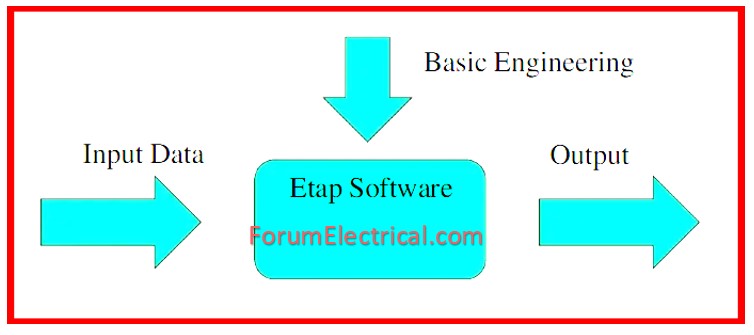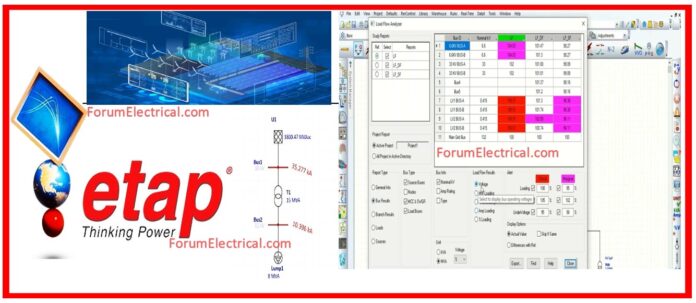ETAP – Electrical Transient and Analysis Program
ETAP Software
ETAP stands for Electrical Transient and Analysis Program. It is the most comprehensive analysis tool for designing, simulating, operating, and automating generating, distribution, & industrial power systems.
- ETAP Software
- ETAP Load Flow Study – Run & Input Data Requirements
- Overview of Load Flow Study
- Input Data Requirements
- System Configuration
- Bus Data
- Branch Data
- Power Grid Data
- Synchronous Generator Data
- Inverter Data
- Synchronous Motor Data
- Induction Motor Data
- Static Load Data
- Capacitor Data
- Lumped Load Data
- Charger & UPS Data
- Run Data Requirements
- Running Load Flow Analysis
- What is Load Flow Analysis in ETAP?

For power system analysis, ETAP software (or) ETAP simulator is a great tool that lets one simulate single-line diagrams of power systems and events including
- Load analysis,
- Power flow, and
- Short-circuit current computation at the buses.
ETAP Load Flow Study – Run & Input Data Requirements
Overview of Load Flow Study
In ETAP, a load flow analysis examines the steady-state running conditions of an electrical power system including
- Voltage levels,
- Power losses, and
- Power distribution
over buses and branches.
It guarantees correct equipment sizing, dependability, and efficiency of systems.
Input Data Requirements
A load flow study in ETAP requires the following information:
System Configuration
Single-line diagram including
- Generators,
- Transformers,
- Loads,
- Buses, and
- Transmission lines.
Bus Data
For bus load flow computations, necessary information consists of:
- Nominal kV
- %V and Angle (using Use Bus Voltages for Initial Condition)
- Load Diversity Factor (should the Loading option be enabled to apply Diversity Factor)
Branch Data
Branch data is entered into the Branch Editors which is, Transformer, Transmission Line, Cable, Reactor, and Impedance Editor.
Load flow computations for branching call for certain data including:
If relevant, branch Z, R, X, (or) X/R values & units; tolerance; temperature if required
- Length, unit, cable & transmission line,
- Transformer rated kV & kVA/MVA; tap; LTC settings
- Impedance Base kV & base kVA/MVA.
Power Grid Data
For power grids, necessary data for the load flow calculations consists of:
- Operating mode – MVar Control, Swing, Voltage Control
- Nominal kV
- Swing mode’s – %V and angle
- Voltage control mode of operation’s %V, MW loading, and MVar limitations (Qmax & Qmin)
- MVar control mode loading for MW and MVar.
Synchronous Generator Data
Load flow calculations for the synchronous generators consider for certain data including:
- Operating mode – MVar control, swing, voltage control
- KV rating
- %V & Angle for the Swing Mode of Operation
- For Voltage Control Mode of Operation: %V, MW loading, and Mvar limitations (Qmax & Qmin)
- MVar control mode of operation loading for MW and Mvar.

Inverter Data
Load flow computations for inverters require specific data including:
- Inverter ID
- DC & AC rating data
- AC output voltage regulating information data
Synchronous Motor Data
Load flow computations for synchronous motors require certain data including:
- kV and rated kW/HP
- Power factors & efficiencies at 100%, 75%, and 50% loadings.
- Loading Category ID & % Load
- Data regarding equipment cables
Induction Motor Data
Load flow computations for induction motors refer to certain data including:
- Rated kV/HP & kW/HP
- Power factors & efficiencies at 100%, 75%, and 50% loadings.
- % Loading and Loading Category
- Data regarding equipment cables
Static Load Data
Load flow computations for stationary loads which include certain data including:
- Static Load ID
- Rated kV and kVA/MVA.
- Power factor
- Loading category & % loading
- Data regarding equipment cables.
Capacitor Data
For stationary loads, necessary information for load flow computations consists in:
- Capacitor ID
- Number of banks, kV, kvar/bank,
- Load category ID & %Loadings
- Equipment cable data
Lumped Load Data
Load flow computations for stationary loads which include data:
- ID Load
- Designed kV, MVA, power factor, & % motor load.
- Load category ID & %Loadings.
Charger & UPS Data
- Load flow calculations for UPSs and chargers call for certain data including:
- Element ID.
- Rated DC rating data, Rated AC kV, MVA, & power factor
- Load category ID & %Loadings.
Run Data Requirements
Certain study case run data needs to also be provided. This includes:
- Newton-Raphson, Fast-decoupled, Accelerated Gauss-Seidel – methods
- Max Iteration
- Accuracy
- Acceleration Factor (should one choose the Accelerated Gauss-Seidel approach)
- Loading Category
- First Condition
- Report (Report Format)
- Update utilizing load flow result for bus voltages & transformer LTCs.
Running Load Flow Analysis
Once the data entered into ETAP:
- Choose the module Load Flow Studies.
- Select a solution approach: Newton-Raphson, Gauss-Seidel, Fast-Decoupled, or another.
- Specify tolerance limits and power flow restrictions.
- Analyze and check loading circumstances, power losses, and voltage profiles.
- Create reports and, when necessary, act with corrections.
A good load flow assessment ensures the system runs inside safe voltage limits and maximizes power distribution for dependability and economy.
What is Load Flow Analysis in ETAP?
Load Flow (or) Power Flow Analysis is the computational technique (numerical algorithms) used to evaluate the steady-state operational characteristics of a power system network based on line and bus data.









